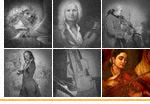FIDDLE TUNES
SECTION 6.10
Fiddle Tunes Chart [128 - 134]
The following fiddle tunes chart provides information about selected fiddle music forms
| Air | A melody, tune or song. In fiddle music, airs generally are played slowly, often with rubato, and are not dance tunes. |
| Breakdown | A general term for fast, lively duple (2/4) and quadruple (4/4) dance tunes (the breakdown is synonymous with the hoedown). |
| Contredanse | Also referred to as contra dance, contredanse is French for “country dance,” and this dance form was derived from the English country dance. The French called a set of contredanses, “quadrille de contredanses,” and this was later shortened to quadrille. The square dance is considered to be based on the French quadrille or contredanse. |
| Crooked tunes | A French-Canadian form of fiddle music, crooked tunes are irregularly structured pieces with extra measures, beats or changes in the meter which have been added to suit the melody (also called airs tordus). |
| Gangar | A Norwegian couples dance with a duple meter and a slow and steady pace. |
| Halling | A Norwegian dance for a solo man in a fast, duple meter. |
| Hoedown | A general term for a fast, lively duple (2/4) or quadruple (4/4) dance tune (the hoedown is synonymous with the breakdown). |
| Hornpipe | A lively British dance, popular during the 16th-19th centuries. Meters used in the hornpipe dance were 2/4, 4/4, and 3/2 (3/2 was the meter used in the British country dance; a dance form similar to the reel, but with a different meter). The tempo of the hornpipe is generally slower than a reel, and rhythms most commonly encountered in hornpipe fiddle dances include 2/4 and 4/4 dotted rhythms such as: Hornpipe rhythm |
| Jig | The jig, a popular and lively dance that originated in Ireland, is popular throughout the British Isles. There are three main forms of jigs:
 Single Jig  Double Jig  Slip Jig |
| March | A piece with a steady, walking (or marching) beat in duple meter (2/4 or 6/8). Marches are often used for events such as weddings and military processionals. |
| One step | A ballroom dance with quick, walking steps, performed to a fast march in 2/4 or 6/8 time (the one step later evolved into the quickstep and “trot” dances such as the foxtrot). |
| Polka | Originally a peasant round dance from Bohemia, the polka is a lively couples dance in duple meter (2/4). The typical rhythm is:
 Polka Rhythm |
| Polska | The polska is derived from the Polish dance polonaise, and it is a Scandinavian dance in 3/4 time (there are several forms used). The polska is generally played slower than a waltz, and the beat emphasis is ONE-two-THREE in each measure. |
| Quadrille | Quadrille was originally the name for a French dance, and it comes from the French expression for a set of contredanses, “quadrille de contredanses” (this was later shortened to quadrille). The square dance is considered to be based on the French quadrille or contredanse. Fiddle tunes called quadrilles) often have meters of 6/8 (sometimes 2/4). |
| Quickstep | A fast version of the foxtrot. The quickstep uses a duple meter, and regular, four-bar phrases. |
| Rag | Rag is a piece composed in the musical style called ragtime, a style that features a ragged or syncopated rhythm. Rags are often in duple meter (2/4 or 4/4). |
| Reel | Originally a Scottish dance, the reel is a fast dance with duple (2/4) or quadruple (4/4) meter (typical Scottish meters are 2/2, 2/4, or 6/8). It generally has a binary form (two parts). |
| Riff | A short, repeated melodic pattern. |
| Schottische | The schottishe is similar to a slow version of a polka. It is a round dance, often in 2/4 time. Different variants of the schottishe include the Highland Schottishe (the Scottish Highland Fling) and the British Barn Schottish (the barn dance, which was a couples dance). |
| Slåtter | A general term for traditional Norwegian folk music. A few of the specific forms of slåtter include halling, gangar and springar. |
| Slide | The slide is basically a single jig, and is a dance form used in Ireland. |
| Springar | A Norwegian couples dance in triple meter. This dance is also called pols in Norwegian, and polska in Swedish music. |
| Square-dance | A popular early American dance, based on the contredanse. This dance is performed by sets of four couples facing each other in a square, and dance moves are announced by a caller. |
| Strathspey | A lively Scottish dance that features the Scotch Snap rhythm (also called Scots Snap) in both the regular and inverted form. The strathspey is usually in quadruple time, and it includes many dotted notes, and is a slower version of a reel.
 Scots Snap Rhythm  Strathspey Rhythm |
| Swing | Swing rhythm often refers to a triplet feel such as interpreting eighth notes as follows:
 Swing Rhythm |
| Two step | A fast American ballroom dance, generally with a 6/8 meter. The rhythm in each bar is: quick-quick-slow. |
| Waltz | A slow dance in triple meter, often with an accent on the first beat of the measure (e.g. ONE, two, three; ONE, two, three). |
© Copyright 2024 RK Deverich. All rights reserved.
*Although this online viola class is provided free of charge, all rights are reserved and this content is protected by international copyright law. It is illegal to copy, post or publish this content in any form, and displaying any of this material on other websites, blogs or feeds is prohibited. Permission is given for individual users to print pages from this website for their personal, non-commercial use.


